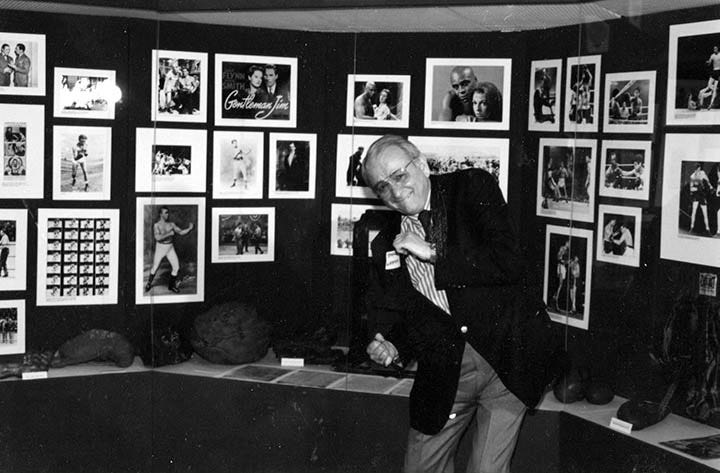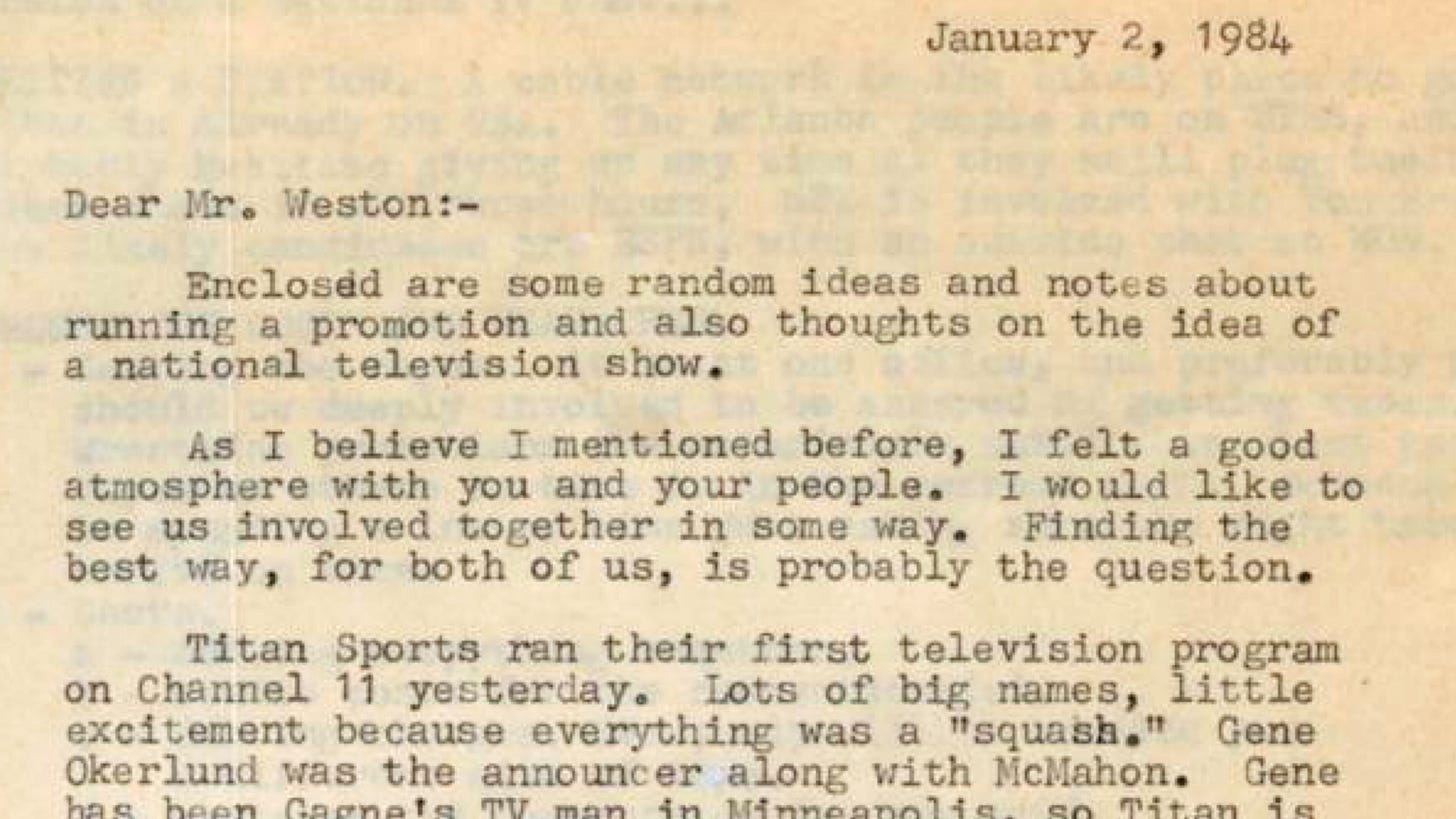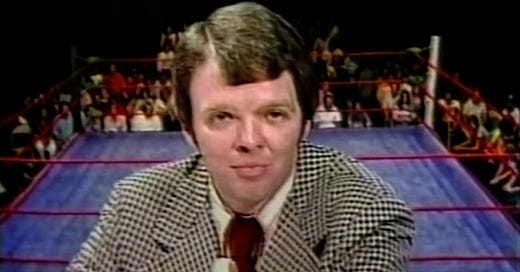Read this letter where Larry Matysik gives a crash course in promoting pro wrestling
Sent to Stanley Weston of all people as part of a dialogue about launching a Pro Wrestling Illustrated TV show to fight off the WWF...

I’ve said this a lot since he passed away in 2018, but former St. Louis announcer/booker/general manager/promoter Larry Matysik was one of the greatest resources that wrestling historians ever had. He had an amazing memory, kept a lot of old documents, and was incredibly giving with his time to historians, reporters, and podcasters who had questions for him. Personally, I greatly regret not tapping into him more while he was still here.
Anyway, a while back, I discovered that the University of Notre Dame Rare Books & Special Collections repository had a little bit more wrestling history than most historians realized it did. It was already well-known that Notre Dame houses the Jack Pfefer Wrestling Collection, the byproduct of the famously eccentric promoter somehow being a massive hoarder despite spending his adult life living in hotels. However, it also has the Stanley Weston Collection, from the archives of the late publisher of the London Publishing/Victory Sports Series/TV Sports series of wrestling magazines that Pro Wrestling Illustrated became the jewel of when it launched in 1979. However, Weston’s true passion was boxing — The Ring was among his holdings — and as such, the overwhelming majority of the documents in the collection is boxing-centric content. Still, there was enough interesting-looking wrestling stuff that I made a point of getting ahold of it all.

The most interesting documents generally involved communications with and about the WWF, which banned domestic wrestling magazines from shooting ringside when it launched its own magazine in late 1983. (In fact, that magazine quickly switched from being called Victory Magazine to WWF Magazine because of legal threats from Weston. With how odd and bad of a name Victory Magazine was, it’s easy to see why Weston and company would see it as a deliberate attempt to cause confusion in the marketplace with the Victory Sports Series.) One of these days, possibly for PWI itself, I’m going to do a whole article about this, especially how it led to a proposal for a PWI TV show that would join up with the non-WWF promotions to fight off the expansion. In the meantime, though, since it came up while Kris Zellner and I were recording next week’s episode of Between the Sheets, I decided it was worth posting one of the documents in that set: A letter that Larry Matysik — technically working for the WWF as the local agent in St. Louis but not happy about it — sent Weston laying out the basics of running a promotion and producing wrestling television.
I am not exaggerating one bit when I say that the meat of the typewritten letter, the six pages containing all of Larry’s advice about running a promotion and producing TV, is one of the most informative things I’ve ever read about pro wrestling. (It’s sandwiched between an introductory page and a copy of a WWF booking contract for international tours.) This thing is dense with information. If you want to read the original, I’ve uploaded it to DocumentCloud, but I figured it was also worth posting the text of those key six pages here. I’ve added some light formatting to make it a little more readable (most just making some text bold and removing page headings), but otherwise, it’s unchanged. Enjoy!

Production of a national TV Show…
A - GETTING A STATION. A cable network is the likely place to go. Titan is already on USA. The Atlanta people are on WTBS, and probably hesitate giving up any time as they still plug their house shows in all three hours. SPN is involved with Von Erich. The likely candidates are ESPN, with an outside shot at WGN.
B - PRODUCTION COSTS AND HEADACHES.
1 - Getting the tapes. At least one office, and preferably two, should be deeply involved to be assured of getting tapes. Wrestling promotions are notoriously unreliable about getting tapes to others on time or in the correct form. Someone will be spending a lot of time just making sure the right tapes arrive on time.
2 - Costs.
a - editing everything together,
b - studio costs for the commentator(s).
c - dubbing charges. Everybody will be sending you a different size of tape,
d - whatever the commentator (s) are paid,
e - what will the offices want? Selling promoters on the idea this helps them fight McMahon is not going to be easy. They might start with enthusiasm but then lose interest as they concentrate on their own towns.
f - have some office do the production package - butthen you lose control over what is done quality-wise. If this is to compete with Titan, it must be slick.
note...many of the alternatives on helping cut production costs here are the same as on the promotion - get a sponsor, try to get participation from the offices involved and then provide a minute or two giving dates, places and main events for upcoming cards.
note...this is at least a full-time job. Just the bare-bones editing alone of a one hour show every week will take one or, more likely, two days. The rest of the time may be spent just coordinating tapes and getting everything where it has to be on time. I emphasize - WORK AHEAD BY AT LEAST TWO WEEKS. Don’t get stuck on Wednesday with a five minute hold for a tape airing Sunday.
a guess-estimate •• based on St. Louis prices, I would imagine that editing together a classy looking ”best of” type show would run between $2000 and $2$00 per program. Really, the only return is in advertising value as no house shows would be run off the tape to reimburse some of the costs.
HERE IS ANOTHER IDEA ...
This is based on something which almost developed between Sam Muchnick and Haskell Cohen about five years ago.
Sell to a network, likely cable, a weekly or bi-weekly house show. Perhaps sponsorship could be split with the magazine and someone else. But the network would pay for the rights of airing this ”house” show.
In essence, the magazine or its representative would serve as the middle man between the network and tie office promoting the house show. The magazine takes its cut (negotiated) for setting up the deal and the rest goes to the promotion.
Somebody has to pay the announcer (s) and production expenses. Hopefully, this v/ould fall on the network involved. A couple of minutes of time could be negotiated to plug upcoming shows, dates and places and main events. Likewise, time in the show could be used to plug the magazines.
Advantages:
1 - gives promoters outside Titan realm a national showcase for what they are doing.
2 - eliminates concern of editing togeether a show every week and what offices may (or may not) be sending.
3 - more exciting show since it has the "house" setting and better quality matches.
4 - a good vehicle for advertising the magazine.
Disadvantages:
1 - the usual hesitation of wrestling to do anything new or different.
2 - some promoters may try to eliminate the middle man and tie up the entire deal for themselves (actually, a different office should be featured in each program •• this week from Memphis, next week from Minneapolis, next week from Atlanta, etc.)
3 - existing TV contracts between offices and the TV stations they are now on could be a problem.
4 - lack of control over product. Let*s face it. Some promoters have better shows and better talent than others. But then again, that*s true in all sports.
A Wrestling Promotion….
A - TELEVISION, the first and foremost need. A promotion needs a regular time on a meaningful station with which to build the personalities and issues of its talent.
Costs involved for:
1 - Production.
a - need at least 3 cameras, including one portable hand-held at ringside.
b - crew (likely to include camera operators, audio man, switcher, director, tape man, floor director...possibly one or two more depending upon union situation inthe location of taping)
c - facilities (likely to be a truck, unless a studio show is being done...need probably 3 tape machines to be in position for slo-mo and replays, could get by with 2 machines but this will limit what can be done, production-wise…it costs us $3,400 in St. Louis for the truck alone, and the crew ran about another $1,300 on top of that for three one-hour shows) — some locales are not union, and thus the price on crew could be lowered perhaps,
d - tape (1-inch still gives the best quality, although there are plenty of 3/4 cassette and 2 inch shows still around...McMahon and many of those really after top quality, though, have gone or are going to 1 inch tape)
e - possible dubbing costs (as noted later, economically need to run more than one town and this means "dubbing" the shows onto 3, 4 or more tapes...not a huge cost, but still there
f - building costs (if not in studio, then a building must be rented)
g - security (small cost, but still probably needed if the building has any size over 200 people)
h - tickets and advertising (do you charge for the taping? if so, even if not, tickets still have to be printed and distributed)
i - talent (including transportation...obviously, amount paid to talent is not nearly as large as in a "house" show, but it can still mount up for 12 or 14 men)
j - getting on the air (McMahon has changed the rules and it may cost a flat amount per week just to get on the air or block McMahon from taking the spot away...this might also be done by negotiating a percentage of house shows to the station involved)
note...the commercial time within the hour is almost always sold by, and receipts retained by, the station. The usual break would leave about 10 to 12 minutes of time for the station, 45 to 48 minutes for the body of the show itself arid then 2 to 4 minutes of "specific" time for the promotion to plug upcoming cards.
note…one way to help on production costs would be to involve a sponsor, i.e. Miller Beer presents….a company of that sort might be willing to pick up all or part of the production costs for the advertising value obtained…how their time would be built into what the station wants would have to be negotiated, but anything to bring down production costs is a big help.
note…because of the costs involved in production, using the tape in more than one city becomes very important. That means house shows can be run in those locations. The towns do not necessarily have to all be big; money can be made in small markets as well and many of them want entertainment because other forms do not come to their locations except on rare occasion.
last note, added cost….an opening and closing sequence have to be built. This probably entails a full eight hours of production in studio, and could run anywhere from $1,000 to $2,000 as a one-time cost.
B - TALENT, almost on par with television as a need. Recognize that other factions would be trying to block or seduce talent away from a new promotion. People come to see stars, although stars can be built if they have the charisma and the promotion has good television.
1 - costs involved:
a - transportation to and from shows
b - usually the figure paid off to talent runs from 30% to 36% of the net (after taxes) — this is for house shows.
note…how the main events are paid and how the prelims are paid varies widely. One theory is to get 6 or 8 top hands and really take care of them. Then, add another 8 to 10 young wrestlers to fill the card. They aren’t as polished as the top hands, but they work more cheaply. Remember, main events draw the crowds. Nobody pays for the opening bout. Of course, the promotion wants people to leave satisfied so the card needs to be exciting.
c - guarantees…something to think about. If an office were opened running five shows a week, a basic guarantee to the top people might be a good idea in order to protect that talent from others…on individual cards, it still isn’t a terrible idea as long as it doesn’t get out of hand.
d - contracts…very unusual in wrestling, but times may be changing.
C - BUILDINGS AND TOWNS. Some buildings may be tied up in exclusive or blocking agreements with other promotions. The usual costs involved will be some sort of guarantee (in St. Louis, it’s around $3000) and a percentage of the net if it is higher than the guarantee (can run anything from 10% to 20%). Also, the buildings usually include some sort of set costs on set-up or ushers or cleaning, etc. Could also be a box office charge added from other ticket costs if the building box office is used. Often security is extra and police are needed to escort wrestlers to the ring and for ringside security. Also insurance.
D - PEOPLE TO RUN IT.
1 - overall promoter, makes sure everything works and makes final decisions on matches, tickets, etc. Answers to investors. Full-time salary, plus percentage.
2 - booker or dressing room man, works in conjunction and with approval of the promoter. Should be handling much of the phone work on talent and making sure what happens, happens right. Cose to a full-time salary, may be worked in with percentage of the house deal.
3 - publicity, much of this can be handled by promoter but still need someone to concentrate on getting out publicity, coordinating TV promos, writing programs, and/or magazines, …in essence, a detail man. Full-time salary.
4 - tickets, somebody with responsibility to make sure tickets are printed and distributed, makes up show statements, checks on advance sales and advises promoter, HONESTY MUST BE UNQUESTIONED…probably can get on a per-show basis.
5 - office costs — long distance telephone, basic supplies, postage, mailing list if one is utilized, some travel, reimburse calls from home (long distance) on promoter and booker, office rent.
6 - misc. costs — referees, timekeeper, ring announcer, announcers for television…on a per show basis.
note…Possibly the biggest mistake I made in the promotion here was trying to do everything myself. Some of the things I let others do were not handled properly, but you have to make mistakes to find out how things should really work. The promoter has to be able to concentrate on the overall politics and decisions making. If he has to spend time on every little detail, he will end up in a hospital within one year. This is particularly true in a competitive situation. Remember, Titan is a large company now and has a lot of muscle. So, in this type of situation, a good detail man and a reliable booker and an honest ticket (financial) person is essential.
7 - C.P.A. — good idea to run everything through a good accountant, rather than get burned later…probably on a monthly retainer.
WHAT ARE THE “PRO’S”
1 - If London Publishing were involved, it could plug its products and probably write off some taxes some of the costs as advertising. There are many subliminal ways to plug magazines without mentioning them verbally.
2 - Counters Titan and Victory Magazine.
3 - Access, obviously, to whatever is needed or wanted to make the magazines better.
4 - Might make a few dollars — but the realistic fact is that losses must be sustained for some time before a profit could be turned on the promotion itself.
WHAT ARE THE “CON’S”
1 - Lose a bundle of money and go under.
2 - Could detract from the concentrating on putting out magazines.
I’d love to say, please finance me and I’ll run against Titan in St. Louis and we’ll try to build from there. But I am still not sure, by any means, that would be a good idea for your company. This is especially true as long as Geigel-O’Connor-Race-Gagne are in the picture. Three promotions would really be a multiple mess and probably everyone would get hurt.
Titan obviously has a lot of financial muscle and has made a firm commitment to spending what it takes now. To compete with them, requires a class product, and that means a big chunk of money.
One idea we talked about is also running in the New York area. This would surely create confusion in that area and probably cause Titan’s houses to fall off — IF DONE PROPERLY. How many have failed before, including Einhorn?
Here is a concept to consider. If a promotion in the east could make a dent, why not offer to finance someone like Crockett or Anderson in shows throughout the Northeast? They would get a percentage of the house, the magazine sponsors the TV (no production costs here, because they already produce a tape), so the magazine has an outlet and a cut of the house itself.
One further thought on the producing of a television show — follow the example of Von Erich in Dallas and tape house shows, chopping them up into regular one hour TV programs. This makes the level of excitement much higher and can cut some costs — only paying the wrestlers once, all on the same transportation and only one building cost. It would essentially eliminate the “squash” except on selected occasions.


